Abstract
The U.S. Congress has passed legislation requiring the EPA to implement screening tests for identifying endocrine-disrupting chemicals. A series of workshops was sponsored by the EPA, the Chemical Manufacturers Association, and the World Wildlife Fund; one workshop focused on screens for chemicals that alter thyroid hormone function and homeostasis. Participants at this meeting identified and examined methods to detect alterations in thyroid hormone synthesis, transport, and catabolism. In addition, some methods to detect chemicals that bind to the thyroid hormone receptors acting as either agonists or antagonists were also identified. Screening methods used in mammals as well as other vertebrate classes were examined. There was a general consensus that all known chemicals which interfere with thyroid hormone function and homeostasis act by either inhibiting synthesis, altering serum transport proteins, or by increasing catabolism of thyroid hormones. There are no direct data to support the assertion that certain environmental chemicals bind and activate the thyroid hormone receptors; further research is indicated. In light of this, screening methods should reflect known mechanisms of action. Most methods examined, albeit useful for mechanistic studies, were thought to be too specific and therefore would not be applicable for broad-based screening. Determination of serum thyroid hormone concentrations following chemical exposure in rodents was thought to be a reasonable initial screen. Concurrent histologic evaluation of the thyroid would strengthen this screen. Similar methods in teleosts may be useful as screens, but would require indicators of tissue production of thyroid hormones. The use of tadpole metamorphosis as a screen may also be useful; however, this method requires validation and standardization prior to use as a broad-based screen.
Full text
PDF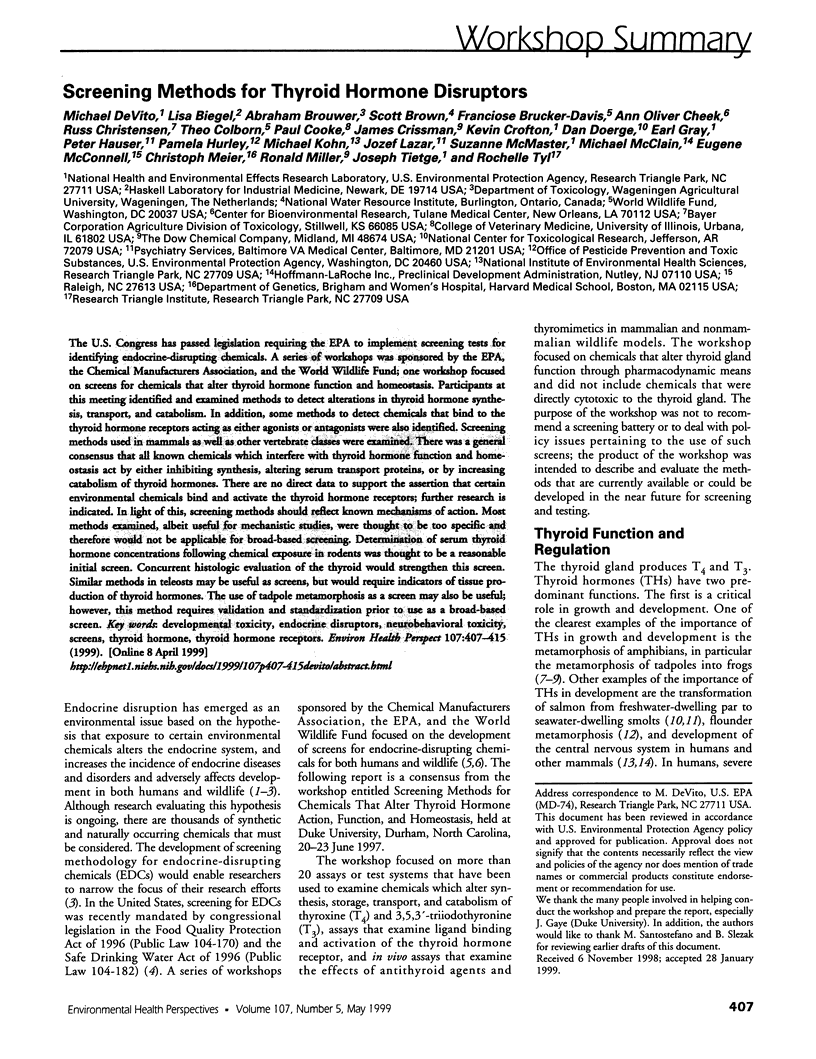


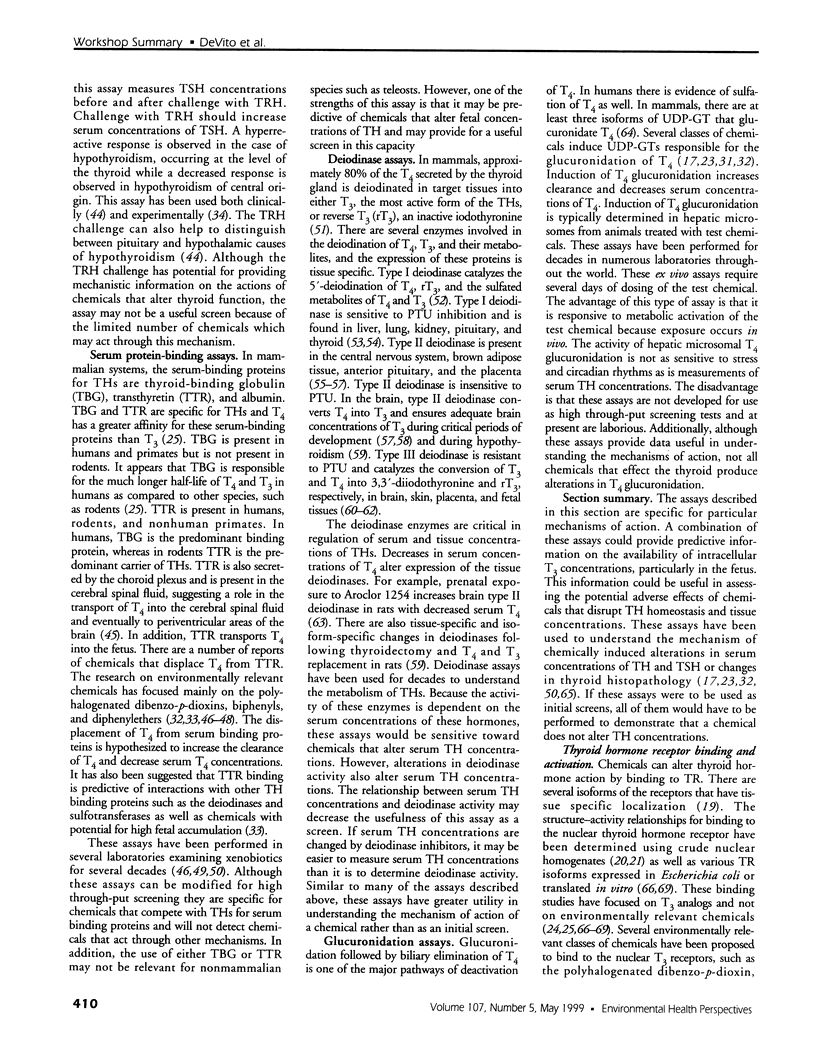
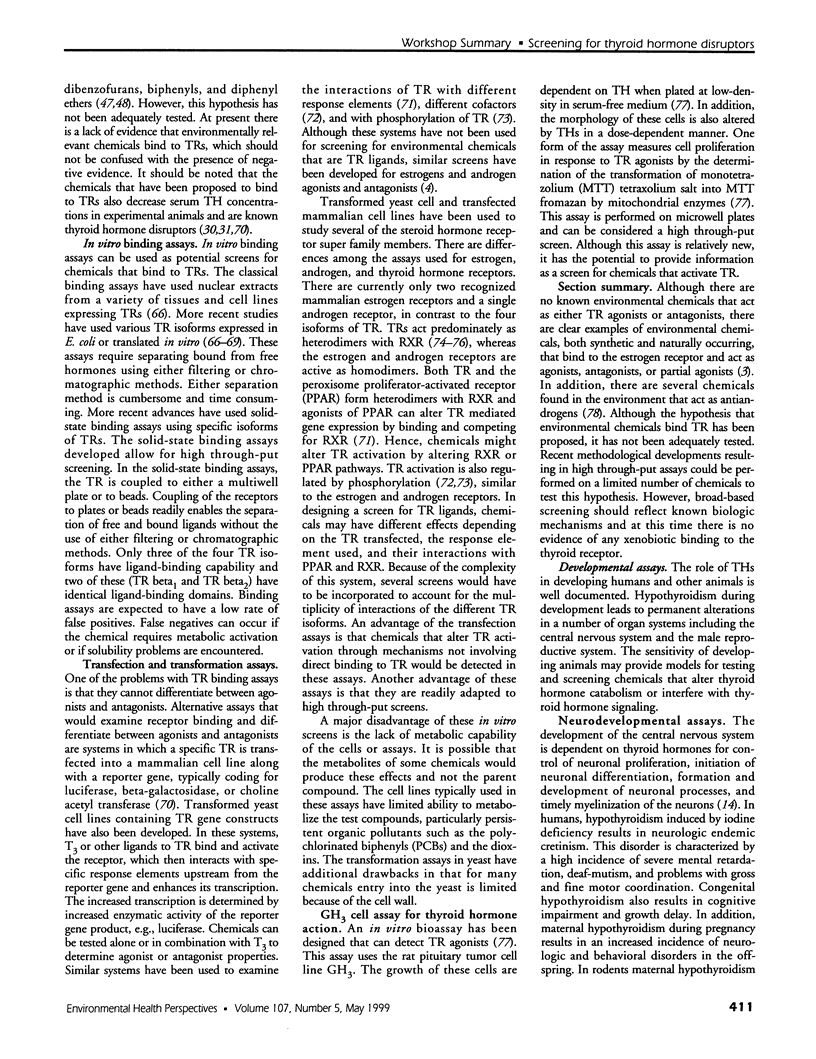
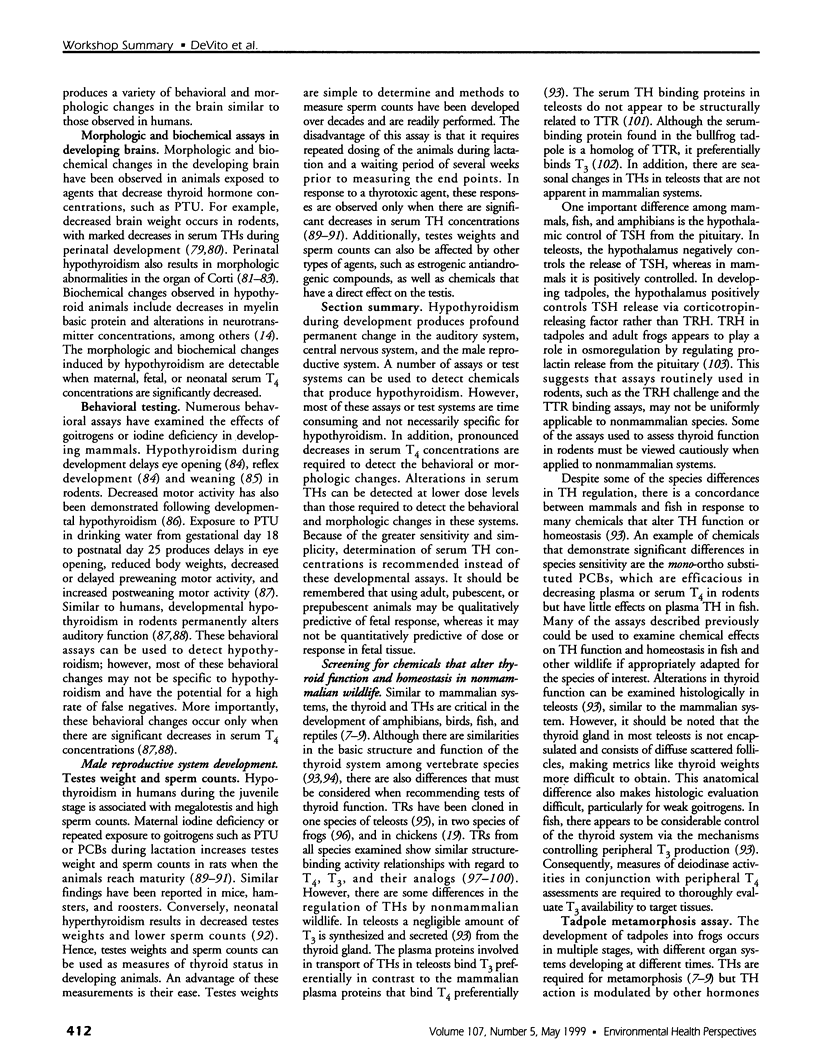
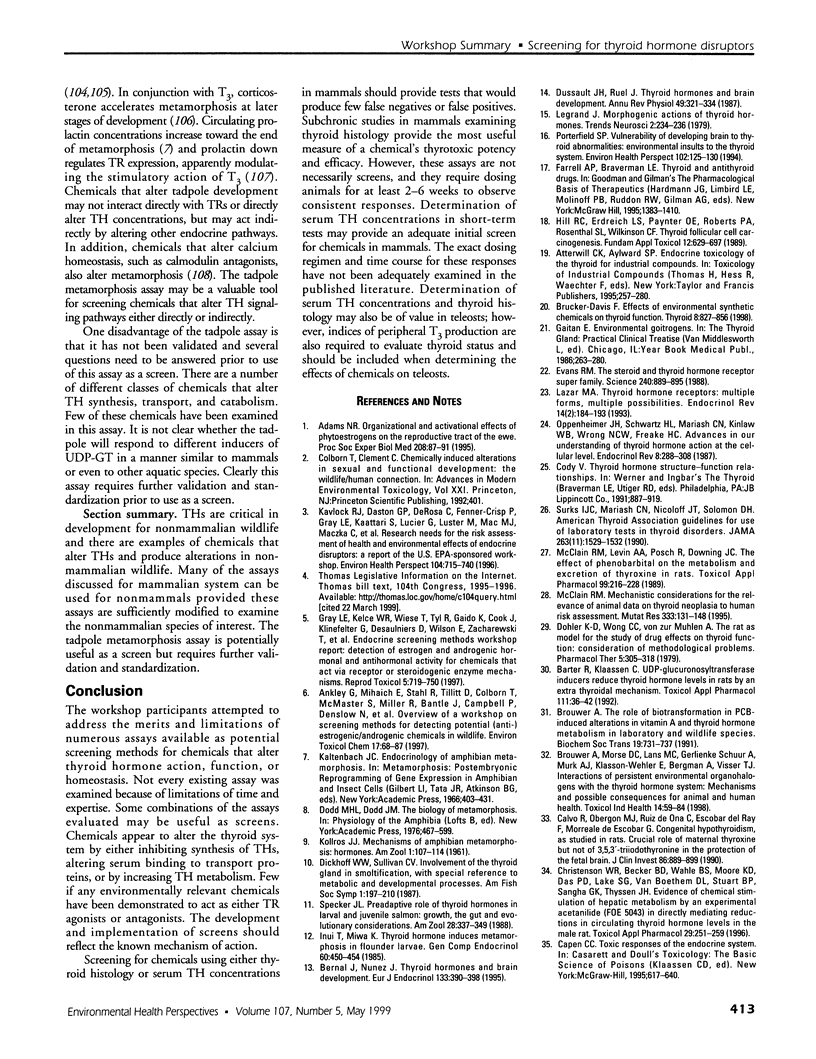


Selected References
These references are in PubMed. This may not be the complete list of references from this article.
- Adams N. R. Organizational and activational effects of phytoestrogens on the reproductive tract of the ewe. Proc Soc Exp Biol Med. 1995 Jan;208(1):87–91. doi: 10.3181/00379727-208-43837. [DOI] [PubMed] [Google Scholar]
- Atterwill C. K., Collins P., Brown C. G., Harland R. F. The perchlorate discharge test for examining thyroid function in rats. J Pharmacol Methods. 1987 Nov;18(3):199–203. doi: 10.1016/0160-5402(87)90070-2. [DOI] [PubMed] [Google Scholar]
- BASCHIERI L., BENEDETTI G., DELUCA F., NEGRI M. EVALUATION AND LIMITATIONS OF THE PERCHLORATE TEST IN THE STUDY OF THYROID FUNCTION. J Clin Endocrinol Metab. 1963 Aug;23:786–791. doi: 10.1210/jcem-23-8-786. [DOI] [PubMed] [Google Scholar]
- Babin P. J. Binding of thyroxine and 3,5,3'-triiodothyronine to trout plasma lipoproteins. Am J Physiol. 1992 May;262(5 Pt 1):E712–E720. doi: 10.1152/ajpendo.1992.262.5.E712. [DOI] [PubMed] [Google Scholar]
- Balázs R., Kovács S., Teichgräber P., Cocks W. A., Eayrs J. T. Biochemical effects of thyroid deficiency on the developing brain. J Neurochem. 1968 Nov;15(11):1335–1349. doi: 10.1111/j.1471-4159.1968.tb05913.x. [DOI] [PubMed] [Google Scholar]
- Barter R. A., Klaassen C. D. UDP-glucuronosyltransferase inducers reduce thyroid hormone levels in rats by an extrathyroidal mechanism. Toxicol Appl Pharmacol. 1992 Mar;113(1):36–42. doi: 10.1016/0041-008x(92)90006-e. [DOI] [PubMed] [Google Scholar]
- Behnam-Rassoli M., Herbert L. C., Howard V., Pharoah P. O., Stanisstreet M. Effect of propylthiouracil treatment during prenatal and early postnatal development on the neocortex of rat pups. Neuroendocrinology. 1991 Apr;53(4):321–327. doi: 10.1159/000125736. [DOI] [PubMed] [Google Scholar]
- Bernal J., Nunez J. Thyroid hormones and brain development. Eur J Endocrinol. 1995 Oct;133(4):390–398. doi: 10.1530/eje.0.1330390. [DOI] [PubMed] [Google Scholar]
- Berrodin T. J., Marks M. S., Ozato K., Linney E., Lazar M. A. Heterodimerization among thyroid hormone receptor, retinoic acid receptor, retinoid X receptor, chicken ovalbumin upstream promoter transcription factor, and an endogenous liver protein. Mol Endocrinol. 1992 Sep;6(9):1468–1478. doi: 10.1210/mend.6.9.1331778. [DOI] [PubMed] [Google Scholar]
- Bhat M. K., Ashizawa K., Cheng S. Y. Phosphorylation enhances the target gene sequence-dependent dimerization of thyroid hormone receptor with retinoid X receptor. Proc Natl Acad Sci U S A. 1994 Aug 16;91(17):7927–7931. doi: 10.1073/pnas.91.17.7927. [DOI] [PMC free article] [PubMed] [Google Scholar]
- Blake H. H., Henning S. J. Effect of propylthiouracil dose on serum thyroxine, growth, and weaning in young rats. Am J Physiol. 1985 May;248(5 Pt 2):R524–R530. doi: 10.1152/ajpregu.1985.248.5.R524. [DOI] [PubMed] [Google Scholar]
- Bres O., Eales J. G. High-affinity, limited-capacity triiodothyronine-binding sites in nuclei from various tissues of the rainbow trout (Salmo gairdneri). Gen Comp Endocrinol. 1988 Jan;69(1):71–79. doi: 10.1016/0016-6480(88)90054-8. [DOI] [PubMed] [Google Scholar]
- Brouwer A., Morse D. C., Lans M. C., Schuur A. G., Murk A. J., Klasson-Wehler E., Bergman A., Visser T. J. Interactions of persistent environmental organohalogens with the thyroid hormone system: mechanisms and possible consequences for animal and human health. Toxicol Ind Health. 1998 Jan-Apr;14(1-2):59–84. doi: 10.1177/074823379801400107. [DOI] [PubMed] [Google Scholar]
- Brouwer A. Role of biotransformation in PCB-induced alterations in vitamin A and thyroid hormone metabolism in laboratory and wildlife species. Biochem Soc Trans. 1991 Aug;19(3):731–737. doi: 10.1042/bst0190731. [DOI] [PubMed] [Google Scholar]
- Brucker-Davis F. Effects of environmental synthetic chemicals on thyroid function. Thyroid. 1998 Sep;8(9):827–856. doi: 10.1089/thy.1998.8.827. [DOI] [PubMed] [Google Scholar]
- Calvo R., Obregón M. J., Ruiz de Oña C., Escobar del Rey F., Morreale de Escobar G. Congenital hypothyroidism, as studied in rats. Crucial role of maternal thyroxine but not of 3,5,3'-triiodothyronine in the protection of the fetal brain. J Clin Invest. 1990 Sep;86(3):889–899. doi: 10.1172/JCI114790. [DOI] [PMC free article] [PubMed] [Google Scholar]
- Cheng S. Y., Ransom S. C., McPhie P., Bhat M. K., Mixson A. J., Wintraub B. D. Analysis of the binding of 3,3',5-triiodo-L-thyronine and its analogues to mutant human beta 1 thyroid hormone receptors: a model of the hormone binding site. Biochemistry. 1994 Apr 12;33(14):4319–4326. doi: 10.1021/bi00180a028. [DOI] [PubMed] [Google Scholar]
- Chopra I. J. A study of extrathyroidal conversion of thyroxine (T4) to 3,3',5-triiodothyronine (T3) in vitro. Endocrinology. 1977 Aug;101(2):453–463. doi: 10.1210/endo-101-2-453. [DOI] [PubMed] [Google Scholar]
- Christenson W. R., Becker B. D., Wahle B. S., Moore K. D., Dass P. D., Lake S. G., Van Goethem D. L., Stuart B. P., Sangha G. K., Thyssen J. H. Evidence of chemical stimulation of hepatic metabolism by an experimental acetanilide (FOE 5043) indirectly mediating reductions in circulating thyroid hormone levels in the male rat. Fundam Appl Toxicol. 1996 Feb;29(2):251–259. doi: 10.1006/faat.1996.0029. [DOI] [PubMed] [Google Scholar]
- Comer C. P., Norton S. Effects of perinatal methimazole exposure on a developmental test battery for neurobehavioral toxicity in rats. Toxicol Appl Pharmacol. 1982 Mar 30;63(1):133–141. doi: 10.1016/0041-008x(82)90032-1. [DOI] [PubMed] [Google Scholar]
- Cooke P. S., Kirby J. D., Porcelli J. Increased testis growth and sperm production in adult rats following transient neonatal goitrogen treatment: optimization of the propylthiouracil dose and effects of methimazole. J Reprod Fertil. 1993 Mar;97(2):493–499. doi: 10.1530/jrf.0.0970493. [DOI] [PubMed] [Google Scholar]
- Cooke P. S., Zhao Y. D., Hansen L. G. Neonatal polychlorinated biphenyl treatment increases adult testis size and sperm production in the rat. Toxicol Appl Pharmacol. 1996 Jan;136(1):112–117. doi: 10.1006/taap.1996.0013. [DOI] [PubMed] [Google Scholar]
- Darling D. S., Dickhoff W. W., Gorbman A. Comparison of thyroid hormone binding to heptic nuclei of the rat and a teleost (Oncorhynchus kisutch). Endocrinology. 1982 Dec;111(6):1936–1943. doi: 10.1210/endo-111-6-1936. [DOI] [PubMed] [Google Scholar]
- Divi R. L., Doerge D. R. Inhibition of thyroid peroxidase by dietary flavonoids. Chem Res Toxicol. 1996 Jan-Feb;9(1):16–23. doi: 10.1021/tx950076m. [DOI] [PubMed] [Google Scholar]
- Divi R. L., Doerge D. R. Mechanism-based inactivation of lactoperoxidase and thyroid peroxidase by resorcinol derivatives. Biochemistry. 1994 Aug 16;33(32):9668–9674. doi: 10.1021/bi00198a036. [DOI] [PubMed] [Google Scholar]
- Doerge D. R., Decker C. J., Takazawa R. S. Chemical and enzymatic oxidation of benzimidazoline-2-thiones: a dichotomy in the mechanism of peroxidase inhibition. Biochemistry. 1993 Jan 12;32(1):58–65. doi: 10.1021/bi00052a009. [DOI] [PubMed] [Google Scholar]
- Dussault J. H., Ruel J. Thyroid hormones and brain development. Annu Rev Physiol. 1987;49:321–334. doi: 10.1146/annurev.ph.49.030187.001541. [DOI] [PubMed] [Google Scholar]
- Döhler K. D., Wong C. C., von zur Mühlen A. The rat as model for the study of drug effects on thyroid function: consideration of methodological problems. Pharmacol Ther B. 1979;5(1-3):305–318. doi: 10.1016/0163-7258(79)90099-8. [DOI] [PubMed] [Google Scholar]
- Engler D., Burger A. G. The deiodination of the iodothyronines and of their derivatives in man. Endocr Rev. 1984 Spring;5(2):151–184. doi: 10.1210/edrv-5-2-151. [DOI] [PubMed] [Google Scholar]
- Escobar-Morreale H. F., Obregón M. J., Hernandez A., Escobar del Rey F., Morreale de Escobar G. Regulation of iodothyronine deiodinase activity as studied in thyroidectomized rats infused with thyroxine or triiodothyronine. Endocrinology. 1997 Jun;138(6):2559–2568. doi: 10.1210/endo.138.6.5212. [DOI] [PubMed] [Google Scholar]
- Evans R. M. The steroid and thyroid hormone receptor superfamily. Science. 1988 May 13;240(4854):889–895. doi: 10.1126/science.3283939. [DOI] [PMC free article] [PubMed] [Google Scholar]
- Galton V. A. Binding of thyroid hormones in vivo by hepatic nuclei of Rana catesbeiana tadpoles. Endocrinology. 1980 Mar;106(3):859–866. doi: 10.1210/endo-106-3-859. [DOI] [PubMed] [Google Scholar]
- Galton V. A. Mechanisms underlying the acceleration of thyroid hormone-induced tadpole metamorphosis by corticosterone. Endocrinology. 1990 Dec;127(6):2997–3002. doi: 10.1210/endo-127-6-2997. [DOI] [PubMed] [Google Scholar]
- Goldey E. S., Kehn L. S., Lau C., Rehnberg G. L., Crofton K. M. Developmental exposure to polychlorinated biphenyls (Aroclor 1254) reduces circulating thyroid hormone concentrations and causes hearing deficits in rats. Toxicol Appl Pharmacol. 1995 Nov;135(1):77–88. doi: 10.1006/taap.1995.1210. [DOI] [PubMed] [Google Scholar]
- Goldey E. S., Kehn L. S., Rehnberg G. L., Crofton K. M. Effects of developmental hypothyroidism on auditory and motor function in the rat. Toxicol Appl Pharmacol. 1995 Nov;135(1):67–76. doi: 10.1006/taap.1995.1209. [DOI] [PubMed] [Google Scholar]
- Gray L. E., Jr, Kelce W. R. Latent effects of pesticides and toxic substances on sexual differentiation of rodents. Toxicol Ind Health. 1996 May-Aug;12(3-4):515–531. doi: 10.1177/074823379601200323. [DOI] [PubMed] [Google Scholar]
- Gray L. E., Jr, Kelce W. R., Wiese T., Tyl R., Gaido K., Cook J., Klinefelter G., Desaulniers D., Wilson E., Zacharewski T. Endocrine Screening Methods Workshop report: detection of estrogenic and androgenic hormonal and antihormonal activity for chemicals that act via receptor or steroidogenic enzyme mechanisms. Reprod Toxicol. 1997 Sep-Oct;11(5):719–750. doi: 10.1016/s0890-6238(97)00025-7. [DOI] [PubMed] [Google Scholar]
- Green W. L. Metabolism of thyroid hormones by rat thyroid tissue in vitro. Endocrinology. 1978 Sep;103(3):826–837. doi: 10.1210/endo-103-3-826. [DOI] [PubMed] [Google Scholar]
- Herbert J., Wilcox J. N., Pham K. T., Fremeau R. T., Jr, Zeviani M., Dwork A., Soprano D. R., Makover A., Goodman D. S., Zimmerman E. A. Transthyretin: a choroid plexus-specific transport protein in human brain. The 1986 S. Weir Mitchell award. Neurology. 1986 Jul;36(7):900–911. doi: 10.1212/wnl.36.7.900. [DOI] [PubMed] [Google Scholar]
- Hill R. N., Erdreich L. S., Paynter O. E., Roberts P. A., Rosenthal S. L., Wilkinson C. F. Thyroid follicular cell carcinogenesis. Fundam Appl Toxicol. 1989 May;12(4):629–697. [PubMed] [Google Scholar]
- Hohenwarter O., Waltenberger A., Katinger H. An in vitro test system for thyroid hormone action. Anal Biochem. 1996 Feb 1;234(1):56–59. doi: 10.1006/abio.1996.0049. [DOI] [PubMed] [Google Scholar]
- Huang T. S., Chopra I. J., Beredo A., Solomon D. H., Chua TecoGN Skin is an active site for the inner ring monodeiodination of thyroxine to 3,3',5'-triiodothyronine. Endocrinology. 1985 Nov;117(5):2106–2113. doi: 10.1210/endo-117-5-2106. [DOI] [PubMed] [Google Scholar]
- Huang T. S., Chopra I. J., Boado R., Soloman D. H., Chua Teco G. N. Thyroxine inner ring monodeiodinating activity in fetal tissues of the rat. Pediatr Res. 1988 Feb;23(2):196–199. doi: 10.1203/00006450-198802000-00014. [DOI] [PubMed] [Google Scholar]
- Inui Y., Miwa S. Thyroid hormone induces metamorphosis of flounder larvae. Gen Comp Endocrinol. 1985 Dec;60(3):450–454. doi: 10.1016/0016-6480(85)90080-2. [DOI] [PubMed] [Google Scholar]
- Iwamuro S., Tata J. R. Contrasting patterns of expression of thyroid hormone and retinoid X receptor genes during hormonal manipulation of Xenopus tadpole tail regression in culture. Mol Cell Endocrinol. 1995 Sep 22;113(2):235–243. doi: 10.1016/0303-7207(95)03634-j. [DOI] [PubMed] [Google Scholar]
- Kaplan M. M., Visser T. J., Yaskoski K. A., Leonard J. L. Characteristics of iodothyronine tyrosyl ring deiodination by rat cerebral cortical microsomes. Endocrinology. 1983 Jan;112(1):35–42. doi: 10.1210/endo-112-1-35. [DOI] [PubMed] [Google Scholar]
- Katz D., Reginato M. J., Lazar M. A. Functional regulation of thyroid hormone receptor variant TR alpha 2 by phosphorylation. Mol Cell Biol. 1995 May;15(5):2341–2348. doi: 10.1128/mcb.15.5.2341. [DOI] [PMC free article] [PubMed] [Google Scholar]
- Kavlock R. J., Daston G. P., DeRosa C., Fenner-Crisp P., Gray L. E., Kaattari S., Lucier G., Luster M., Mac M. J., Maczka C. Research needs for the risk assessment of health and environmental effects of endocrine disruptors: a report of the U.S. EPA-sponsored workshop. Environ Health Perspect. 1996 Aug;104 (Suppl 4):715–740. doi: 10.1289/ehp.96104s4715. [DOI] [PMC free article] [PubMed] [Google Scholar]
- Kirby J. D., Jetton A. E., Cooke P. S., Hess R. A., Bunick D., Ackland J. F., Turek F. W., Schwartz N. B. Developmental hormonal profiles accompanying the neonatal hypothyroidism-induced increase in adult testicular size and sperm production in the rat. Endocrinology. 1992 Aug;131(2):559–565. doi: 10.1210/endo.131.2.1639007. [DOI] [PubMed] [Google Scholar]
- Kumar B. A., Vinod K. R., Paul V. F., Pilo B. Effect of calcium and calmodulin antagonists on metamorphosis in the anuran tadpole, Rana tigerina. Funct Dev Morphol. 1993;3(4):237–242. [PubMed] [Google Scholar]
- Lans M. C., Spiertz C., Brouwer A., Koeman J. H. Different competition of thyroxine binding to transthyretin and thyroxine-binding globulin by hydroxy-PCBs, PCDDs and PCDFs. Eur J Pharmacol. 1994 Apr 4;270(2-3):129–136. doi: 10.1016/0926-6917(94)90054-x. [DOI] [PubMed] [Google Scholar]
- Lazar M. A. Thyroid hormone receptors: multiple forms, multiple possibilities. Endocr Rev. 1993 Apr;14(2):184–193. doi: 10.1210/edrv-14-2-184. [DOI] [PubMed] [Google Scholar]
- MORGANS M. E., TROTTER W. R. Defective organic binding of iodine by the thyroid in Hashimoto's thyroiditis. Lancet. 1957 Mar 16;272(6968):553–555. doi: 10.1016/s0140-6736(57)90921-2. [DOI] [PubMed] [Google Scholar]
- McClain R. M., Levin A. A., Posch R., Downing J. C. The effect of phenobarbital on the metabolism and excretion of thyroxine in rats. Toxicol Appl Pharmacol. 1989 Jun 15;99(2):216–228. doi: 10.1016/0041-008x(89)90004-5. [DOI] [PubMed] [Google Scholar]
- McClain R. M. Mechanistic considerations for the relevance of animal data on thyroid neoplasia to human risk assessment. Mutat Res. 1995 Dec;333(1-2):131–142. doi: 10.1016/0027-5107(95)00139-5. [DOI] [PubMed] [Google Scholar]
- McKinney J. D., Waller C. L. Polychlorinated biphenyls as hormonally active structural analogues. Environ Health Perspect. 1994 Mar;102(3):290–297. doi: 10.1289/ehp.94102290. [DOI] [PMC free article] [PubMed] [Google Scholar]
- Meier C. A., Parkison C., Chen A., Ashizawa K., Meier-Heusler S. C., Muchmore P., Cheng S. Y., Weintraub B. D. Interaction of human beta 1 thyroid hormone receptor and its mutants with DNA and retinoid X receptor beta. T3 response element-dependent dominant negative potency. J Clin Invest. 1993 Oct;92(4):1986–1993. doi: 10.1172/JCI116793. [DOI] [PMC free article] [PubMed] [Google Scholar]
- Morse D. C., Wehler E. K., Wesseling W., Koeman J. H., Brouwer A. Alterations in rat brain thyroid hormone status following pre- and postnatal exposure to polychlorinated biphenyls (Aroclor 1254). Toxicol Appl Pharmacol. 1996 Feb;136(2):269–279. doi: 10.1006/taap.1996.0034. [DOI] [PubMed] [Google Scholar]
- Obregón M. J., Ruiz de Oña C., Calvo R., Escobar del Rey F., Morreale de Escobar G. Outer ring iodothyronine deiodinases and thyroid hormone economy: responses to iodine deficiency in the rat fetus and neonate. Endocrinology. 1991 Nov;129(5):2663–2673. doi: 10.1210/endo-129-5-2663. [DOI] [PubMed] [Google Scholar]
- Ogilvie L. M., Ramsden D. B. Ioxynil and 3,5,3'-triiodothyronine: comparison of binding to human plasma proteins. Toxicol Lett. 1988 Dec;44(3):281–287. doi: 10.1016/0378-4274(88)90167-1. [DOI] [PubMed] [Google Scholar]
- Oppenheimer J. H., Schwartz H. L., Mariash C. N., Kinlaw W. B., Wong N. C., Freake H. C. Advances in our understanding of thyroid hormone action at the cellular level. Endocr Rev. 1987 Aug;8(3):288–308. doi: 10.1210/edrv-8-3-288. [DOI] [PubMed] [Google Scholar]
- Poole A., Pritchard D., Jones R. B., Catto L., Leonard T. In vivo biliary excretion and in vitro cellular accumulation of thyroxine by rats or cultured rat hepatocytes treated with a novel histamine H1-receptor antagonist. Arch Toxicol. 1990;64(6):474–481. doi: 10.1007/BF01977630. [DOI] [PubMed] [Google Scholar]
- Porterfield S. P. Vulnerability of the developing brain to thyroid abnormalities: environmental insults to the thyroid system. Environ Health Perspect. 1994 Jun;102 (Suppl 2):125–130. doi: 10.1289/ehp.94102125. [DOI] [PMC free article] [PubMed] [Google Scholar]
- Rastogi R. B., Lapierre Y., Singhal R. L. Evidence for the role of brain biogenic amines in depressed motor activity seen in chemically thyroidectomized rats. J Neurochem. 1976 Mar;26(3):443–449. doi: 10.1111/j.1471-4159.1976.tb01494.x. [DOI] [PubMed] [Google Scholar]
- Reginato M. J., Zhang J., Lazar M. A. DNA-independent and DNA-dependent mechanisms regulate the differential heterodimerization of the isoforms of the thyroid hormone receptor with retinoid X receptor. J Biol Chem. 1996 Nov 8;271(45):28199–28205. doi: 10.1074/jbc.271.45.28199. [DOI] [PubMed] [Google Scholar]
- Ruiz de Oña C., Morreale de Escobar G., Calvo R., Escobar del Rey F., Obregón M. J. Thyroid hormones and 5'-deiodinase in the rat fetus late in gestation: effects of maternal hypothyroidism. Endocrinology. 1991 Jan;128(1):422–432. doi: 10.1210/endo-128-1-422. [DOI] [PubMed] [Google Scholar]
- Schueler P. A., Schwartz H. L., Strait K. A., Mariash C. N., Oppenheimer J. H. Binding of 3,5,3'-triiodothyronine (T3) and its analogs to the in vitro translational products of c-erbA protooncogenes: differences in the affinity of the alpha- and beta-forms for the acetic acid analog and failure of the human testis and kidney alpha-2 products to bind T3. Mol Endocrinol. 1990 Feb;4(2):227–234. doi: 10.1210/mend-4-2-227. [DOI] [PubMed] [Google Scholar]
- Silva J. E., Leonard J. L., Crantz F. R., Larsen P. R. Evidence for two tissue-specific pathways for in vivo thyroxine 5'-deiodination in the rat. J Clin Invest. 1982 May;69(5):1176–1184. doi: 10.1172/JCI110554. [DOI] [PMC free article] [PubMed] [Google Scholar]
- Sullivan C. V., Darling D. S., Dickhoff W. W. Nuclear receptors for L-triiodothyronine in trout erythrocytes. Gen Comp Endocrinol. 1987 Jan;65(1):149–160. doi: 10.1016/0016-6480(87)90234-6. [DOI] [PubMed] [Google Scholar]
- Surks M. I., Chopra I. J., Mariash C. N., Nicoloff J. T., Solomon D. H. American Thyroid Association guidelines for use of laboratory tests in thyroid disorders. JAMA. 1990 Mar 16;263(11):1529–1532. [PubMed] [Google Scholar]
- Takayama S., Aihara K., Onodera T., Akimoto T. Antithyroid effects of propylthiouracil and sulfamonomethoxine in rats and monkeys. Toxicol Appl Pharmacol. 1986 Feb;82(2):191–199. doi: 10.1016/0041-008x(86)90194-8. [DOI] [PubMed] [Google Scholar]
- Tata J. R. Hormonal regulation of programmed cell death during amphibian metamorphosis. Biochem Cell Biol. 1994 Nov-Dec;72(11-12):581–588. doi: 10.1139/o94-077. [DOI] [PubMed] [Google Scholar]
- Uziel A., Gabrion J., Ohresser M., Legrand C. Effects of hypothyroidism on the structural development of the organ of Corti in the rat. Acta Otolaryngol. 1981 Nov-Dec;92(5-6):469–480. doi: 10.3109/00016488109133286. [DOI] [PubMed] [Google Scholar]
- Uziel A., Legrand C., Ohresser M., Marot M. Maturational and degenerative processes in the organ of Corti after neonatal hypothyroidism. Hear Res. 1983 Aug;11(2):203–218. doi: 10.1016/0378-5955(83)90079-5. [DOI] [PubMed] [Google Scholar]
- Van Birgelen A. P., Smit E. A., Kampen I. M., Groeneveld C. N., Fase K. M., Van der Kolk J., Poiger H., Van den Berg M., Koeman J. H., Brouwer A. Subchronic effects of 2,3,7,8-TCDD or PCBs on thyroid hormone metabolism: use in risk assessment. Eur J Pharmacol. 1995 May 26;293(1):77–85. doi: 10.1016/0926-6917(95)90021-7. [DOI] [PubMed] [Google Scholar]
- Van den Berg K. J., van Raaij J. A., Bragt P. C., Notten W. R. Interactions of halogenated industrial chemicals with transthyretin and effects on thyroid hormone levels in vivo. Arch Toxicol. 1991;65(1):15–19. doi: 10.1007/BF01973497. [DOI] [PubMed] [Google Scholar]
- Visser T. J., Kaplan M. M., Leonard J. L., Larsen P. R. Evidence for two pathways of iodothyronine 5'-deiodination in rat pituitary that differ in kinetics, propylthiouracil sensitivity, and response to hypothyroidism. J Clin Invest. 1983 Apr;71(4):992–1002. doi: 10.1172/JCI110854. [DOI] [PMC free article] [PubMed] [Google Scholar]
- Visser T. J., Kaptein E., van Toor H., van Raaij J. A., van den Berg K. J., Joe C. T., van Engelen J. G., Brouwer A. Glucuronidation of thyroid hormone in rat liver: effects of in vivo treatment with microsomal enzyme inducers and in vitro assay conditions. Endocrinology. 1993 Nov;133(5):2177–2186. doi: 10.1210/endo.133.5.8404669. [DOI] [PubMed] [Google Scholar]
- Wolff J. Perchlorate and the thyroid gland. Pharmacol Rev. 1998 Mar;50(1):89–105. [PubMed] [Google Scholar]
- Wright M. L., Cykowski L. J., Lundrigan L., Hemond K. L., Kochan D. M., Faszewski E. E., Anuszewski C. M. Anterior pituitary and adrenal cortical hormones accelerate or inhibit tadpole hindlimb growth and development depending on stage of spontaneous development or thyroxine concentration in induced metamorphosis. J Exp Zool. 1994 Oct 1;270(2):175–188. doi: 10.1002/jez.1402700207. [DOI] [PubMed] [Google Scholar]
- Yamano K., Inui Y. cDNA cloning of thyroid hormone receptor beta for the Japanese flounder. Gen Comp Endocrinol. 1995 Aug;99(2):197–203. doi: 10.1006/gcen.1995.1102. [DOI] [PubMed] [Google Scholar]
- Yamauchi K., Kasahara T., Hayashi H., Horiuchi R. Purification and characterization of a 3,5,3'-L-triiodothyronine-specific binding protein from bullfrog tadpole plasma: a homolog of mammalian transthyretin. Endocrinology. 1993 May;132(5):2254–2261. doi: 10.1210/endo.132.5.8477670. [DOI] [PubMed] [Google Scholar]
- van Beeren H. C., Bakker O., Wiersinga W. M. Structure-function relationship of the inhibition of the 3,5,3'-triiodothyronine binding to the alpha1- and beta1-thyroid hormone receptor by amiodarone analogs. Endocrinology. 1996 Jul;137(7):2807–2814. doi: 10.1210/endo.137.7.8770901. [DOI] [PubMed] [Google Scholar]
- van Haaster L. H., de Jong F. H., Docter R., de Rooij D. G. High neonatal triiodothyronine levels reduce the period of Sertoli cell proliferation and accelerate tubular lumen formation in the rat testis, and increase serum inhibin levels. Endocrinology. 1993 Aug;133(2):755–760. doi: 10.1210/endo.133.2.8344214. [DOI] [PubMed] [Google Scholar]


